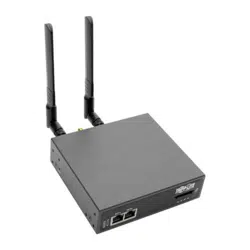Loading ...
Loading ...
Loading ...

147
8. Power, Environment and Digital I/O
Console servers manage Remote Power Control devices (PDUs and IPMI devices) and Uninterruptible Power Supplies (UPS).
They also monitor remote operating environments using Environmental Monitoring Devices (EMDs) and sensors and can
provide digital I/O control.
8.1 Remote Power Control (RPC)
The console server management console monitors and controls Remote Power Control (RPC) devices using the embedded
PowerMan and Network UPS Tools, open source management tools, and Tripp Lite’s power management software. RPCs
include power distribution units (PDUs) and IPMI power devices.
Serial PDUs can be controlled using their command line console, so you could manage the PDU through the console server
using a remote telnet client. Also, you could use proprietary software tools no doubt supplied by the vendor. This generally runs
on a remote Windows PC and you could configure the console server serial port to operate with a serial COM port redirector
in the PC (refer to section 4. Serial Port, Host, Device and User Configuration). Similarly, network-attached PDUs can
be controlled with a browser (e.g., with SDT as detailed in section 6.3 SDT Connector Management Console), an SNMP
management package, or using the vendor-supplied control software. Servers and network-attached devices with embedded
IPMI service processors or BMCs are supplied with their own management tools (like SoL) to provide secure management
when connected using with SDT Connector.
For simplicity, these devices can be controlled through one window with the Management Console’s RPC remote power control
tools.
8.1.1 RPC Connection
Serial and network-connected RPCs must first be connected to and configured to communicate with the console server:
• For serial RPCs, connect the PDU to the selected serial port on the console server. From the Serial and Network: Serial
Port menu, configure the Common Settings of that port with the RS-232 properties required by the PDU (refer to 4.1.1
Common Settings). Select RPC as the Device Type.
• Similarly, for each network-connected RPC go to Serial & Network: Network Hosts menu and configure the RPC as a
connected host by specifying it as Device Type: RPC and clicking Apply (refer to 4.4 Network Hosts).
Loading ...
Loading ...
Loading ...
